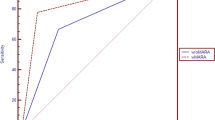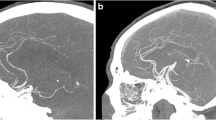Abstract
The purpose of this study was to compare the image quality of two-dimensional (2D) digital subtraction angiography (DSA) between a flat panel detector (FPD) of the direct conversion type with low radiation dose and a conventional image intensifier (I.I.)-TV system, and to assess 3D DSA with the FPD system in the depiction of intracranial vessels. Fifteen consecutive patients (five men, ten women; age range: 18–82 years; mean age: 55.5 years) were prospectively included in this study. All patients underwent 2D DSA with both the FPD and I.I.-TV system in one projection. The radiation doses during angiography were evaluated using a phantom. The 3D DSA images were created from the rotational DSA data with the FPD system. Two blinded radiologists independently evaluated 2D DSA with the FPD system and I.I.-TV system using a 5-point assessment scale (excellent to not visible) to assess the depiction of intracranial vessels. MIP and volume rendering (VR) images of 3D DSA with the FPD system were also evaluated using a 5-point scale (excellent to not visible). DSA and fluoroscopy dose measurements with the phantom showed a dose reduction of approximately 85% and 9% with the FPD system compared with the I.I.-TV system, respectively. For 2D DSA, the FPD system was significantly superior to the I.I.-TV system with respect to the visibility of the peripheral and perforating vessels (p<0.05). The peripheral and perforating vessels were also sufficiently visualized on MIP images of 3D DSA in all 15 cases. Our FPD system was found to be superior to the I.I.-TV system in visualizing small intracranial vessels combined with a significant reduction of radiation dose, and was able to create high-quality 3D DSA images on which high spatial resolution allowed precise visualization of small vessels such as perforating ones.



Similar content being viewed by others
Abbreviations
- DSA:
-
digital subtraction angiography
- 2D:
-
two-dimensional
- 3D:
-
three-dimensional
References
Mahadevappa Mahesh (2004) AAPM/RSNA physics tutorial for residents: digital mammography: an overview. Radiographics 24:1747–1760
Granfors PR, Aufrichtig R (2000) Performance of a 41×41-cm2 amorphous silicon flat panel x-ray detector for radiographic imaging applications. Med Phys 27:1324–1331
Rowlands JA, Hunter DM, Araj N (1991) X-ray imaging using amorphous selenium: a photoinduced discharge readout method for digital mammography. Med Phys 18:421–431
Chotas HG, Dobbins JT, Rabin CE (1999) Principles of digital radiography with large area, electronically readable detectors: a review of the basics. Radiology 210:595–599
Zhao W, Ji WG, Debrie A, Rowlands JA (2003) Imaging performance of amorphous selenium based flat-panel detectors for digital mammography: characterization of a small area prototype detector. Med Phys 30:254–263
Tsukamoto A, Yamada S, Tomisaki T et al (1999) Development and evaluation of a large-area selenium-based flat panel detector for real-time radiography and fluoroscopy. Proc SPIE 3659:14–23
Ricke J, Fischbach F, Freund T et al (2003) Clinical results of CsI-detector-based dual-exposure dual energy in chest radiography. Eur Radiol 13:2577–2582
Volk M, Hamer OW, Feuerbach S et al (2004) Dose reduction in skeletal and chest radiography using a large-area flat-panel detector based on amorphous silicon and thallium-doped cesium iodide: technical background, basic image quality parameters, and review of the literature. Eur Radiol 14:827–834
Noel A, Thibault F (2004) Digital detectors for mammography: the technical challenges. Eur Radiol 14:1990–1998
Jansson M, Geijer H, Persliden J et al (2006) Reducing dose in urography while maintaining image quality-a comparison of storage phosphor plates and a flat-panel detector. Eur Radiol 16:221–226
Zhao W, Blevis I, Germann S, Rowlands JA, Waechter D, Huang Z (1997) Digital radiology using active matrix readout of amorphous selenium: construction and evaluation of a prototype real-time detector. Med Phys 24:1834–1843
Adachi S, Hori N, Sato K et al (2000) Experimental evaluation of a-Se and CdTe flat-panel x-ray detectors for digital radiography and fluoroscopy. Proc SPIE 3977:38–47
Ulrike Rapp-Bernhardt, Friedrich W. Roehl, Robert C et al (2003) Flat-panel X-ray detector based on amorphous silicon versus asymmetric screen-film system: phantom study of dose reduction and depiction of simulated findings. Radiology 227:484–492
Ludwig K, Lenzen H, Kamm KF et al (2002) Performance of a flat-panel detector in detecting artificial bone lesions: comparison with conventional screen-film and storage-phosphor radiography. Radiology 222:453–459
Strotzer M, Volk M, Frund R, Hamer O, Zorger N, Feuerbach S (2002) Routine chest radiography using a flat-panel detector: image quality at standard detector dose and 33% dose reduction. AJR Am J Roentgenol 178:169–171
Adachi S, Hirasawa S, Takahashi M et al (2002) Noise properties of a Se-based flat-panel X-ray detector with CMOS readout integrated circuits. Proc SPIE 4682:580–591
Anxionnat R, Bracard S, Ducrocq X et al (2001) Intracranial aneurysms: clinical value of 3D digital subtraction angiography in the therapeutic decision and endovascular treatment. Radiology 218:799–808
Tanoue S, Kiyosue H, Kenai H et al (2000) Three-dimensional reconstructed images after rotational angiography in the evaluation of intracranial aneurysm: surgical correlation. Neurosurgery 47:866–871
Anxionnat R, Bracard S, Macho J et al (1998) 3D angiography: clinical interest-first applications in interventional neuroradiology. J Neuroradiol 25:251–262
Sugahara T, Korogi Y, Nakashima K, Hamatake S, Honda S, Takahashi M (2002) Comparison of 2D and 3D digital subtraction angiography in evaluation of intracranial aneurysms. AJNR Am J Neuroradiol 23:1545–1552
Hirai T, Korogi Y, Suginohara K et al (2003) Clinical usefulness of unsubtracted 3D digital angiography compared with rotational digital angiography in the pretreatment evaluation of intracranial aneurysms. AJNR Am J Neuroradiol 24:1067–1074
Author information
Authors and Affiliations
Corresponding author
Rights and permissions
About this article
Cite this article
Hatakeyama, Y., Kakeda, S., Korogi, Y. et al. Intracranial 2D and 3D DSA with flat panel detector of the direct conversion type: initial experience. Eur Radiol 16, 2594–2602 (2006). https://doi.org/10.1007/s00330-006-0233-2
Received:
Revised:
Accepted:
Published:
Issue Date:
DOI: https://doi.org/10.1007/s00330-006-0233-2




